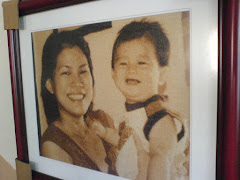Most needlepoint pieces are more or less out of square when finished and must be "blocked" so that they are rectangular in shape.
Here's the easy way:
Using a spray bottle with water in it, mist both sides of your piece evenly. No need to soak it or wash it it, just a light dampening is what you want.
Now roll it up (not too tight) and place it in a plastic bag. Close the bag and put it away for eight to twelve hours.
You will need a piece of 1/2" (thickness) plywood. It must, of course, be a bit larger than the needlepoint you intend to block. You can get plywood up to 4' x 8' (four feet by eight feet) at a lumber yard. Lumber yards will cut these into smaller pieces and in fact often have them cut and in stock. Call them before you go. Be sure to get a grade of plywood that is perfectly smooth on at least one side. The softer the wood the better.
While you are out shopping, borrow or buy a carpenter's square.
A carpenter's square is shaped like an "L". It has a rule of 24 inches down one side and 18" on the other leg.
You will also need a carpenter's pencil and a heavy-duty staple machine with a box of 1/4" staples.
This is not an ordinary pencil or staple machine. The staple machine must drive the staples into wood. The pencil is made to mark on wood. You will find these items at the lumber yard or hardware store. You will need a sharp knife to put a point on the pencil.
Find one of the edges on the plywood that was cut by the mill that made the plywood. It will be perfectly straight and probably smoother than the lumber yard cuts. From this accurately cut edge, measure out and mark a line as shown in A.
Then, using the carpenter's square, mark out a line as in B. Next, complete the rectangle allowing a generous margin all around as in C. Now, you can use the square and lay out any size rectangle using the lines you have drawn on the plywood such as the darker area in D. Note: Some expert blockers use masking tape to mark the lines instead of the pencil. This is an equally good method.
This same board can serve for many blockings. Just draw in a new box for each size as you need it. A board like this could be a club or group project.
Now you are ready to remove the dampened needlepoint canvas from the plastic bag and lay it face down (in most cases) on the board.
Use this method for stretching and fitting along the lines you have drawn: Starting at the upper right corner, position it carefully and staple it in place securely. The staple machine must be held firmly and squarely against the work. You may need to practice with the staple machine in an unused area of your board.
Now go to the lower right corner and do the same. Staple it in place.
Go to the lower left corner. Staple it in place.
Go to the upper left corner. Staple it in place.
All corners should be now be fastened securely in place.
Now, straighten the right edge and staple. Next the lower edge. Then the left edge. Finally, the top edge.
If the needlepoint canvas is properly dampened and prepared, it should be just that easy to get it stretched squarely along your lines.
Be careful to staple as far out in the non-worked area of your canvas as possible as the staples may cut some of the fibers of the canvas.
After stapling, put the board in a warm, dry place. Leave it alone for twenty-four hours or until you are satisfied that it is completely dry. Then, remove the staples carefully. A sharpened blade-type screwdriver is the best tool for this. You should have a perfect job.
Can you use nails or tacks to fasten the canvas to the board? Yes, you can use anything you can work with easily. Just remember, you must be able to remove anything you pound into the board!
Do the fasteners have to be rust-proof? No, they are in contact with the canvas for only a short period, then are discarded.
Should the board be painted before using? That is up to you. It couldn't hurt anything.
Can I use other marking pencils and pens on the board? Only at your own risk. We use only the pencil. To prevent any graphite from rubbing off onto your needlepoint, you can spray your markings with a light coat of clear Krylon or other clear quick-drying paint.
I have read that some people have their board covered with gingham and use the squares in the cloth to align their edges. Will that work? Yes, this method has been used for many, many years. The key to using gingham successfully is getting it straight and fastened to the board. Not as easy as it sounds.
Are there any real pitfalls? Maybe. Many pieces have been ruined by soaking in water, washing with various soaps, and dry cleaning. Even the light dampening that we use can cause some marking pen marks to bleed and ruin your work. Many marking pens that are supposed to be permanent are not!
source: www.needlepointfun.com
Wednesday, September 24, 2008
Subscribe to:
Post Comments (Atom)







No comments:
Post a Comment